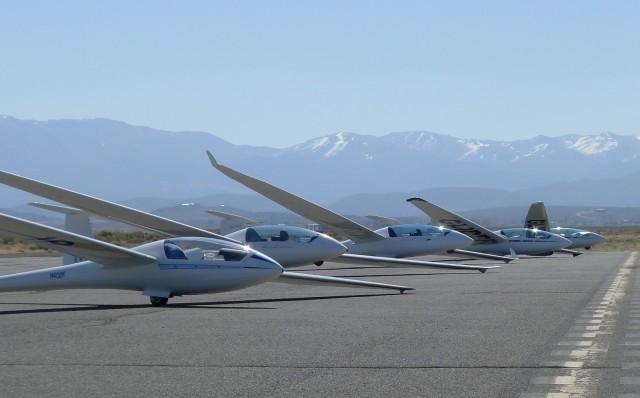
Soaring NV’s gliders at Minden-Tahoe Airport – the LS4, two Duo Discus, two ASK-21s
Photo: Soaring NV
I’ve been waiting for you!
I’m glad that you decided to come along with me for a flight in Soaring NV’s LS4 glider. I promised you a ride in Gone Gliding, Part One, didn’t I? Yes, the LS4 is just a single-seater, so we’ll use a ’œmind-meld’ for you to enjoy the flight. Let’s hop into a golf cart with Spencer, who’ll be our ground crew, and head over to the glider staging area near the threshold of Runway 30, here at Minden-Tahoe Airport (MEV).
While Spencer drives us over, he’ll be making radio calls on his handheld to update air and ground traffic with our progress along the taxiways and across the runways. MEV doesn’t have a control tower, and it’s important that we communicate as we go. So I’ll tell you what I’ve been up to, before you arrived.
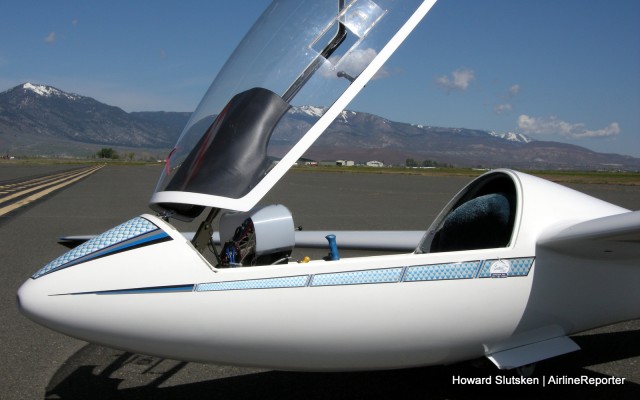
The LS4 waits for us in the staging area near the threshold of Runway 30. I only left the canopy up long enough to quickly take this photo on a no-wind day – a strong breeze could smack it down and damage it.
I’ve checked the weather, and had a good look at the soaring forecast. The National Oceanic and Atmospheric Administration (NOAA) publishes a daily forecast for the Reno area that gives glider pilots an idea of the lift, temperatures, and winds aloft for the day. It’s a beautiful afternoon in the Carson Valley, warm, with just a few puffy cumulus clouds out there around 14,000 feet above sea level (ASL). I’ve also talked with a couple of pilots who’ve just landed, and they told me that there’s some booming thermals just a couple of miles east of the airport. Great!
Spencer towed the glider over from the ramp earlier today, and I’ve done the pre-flight. That included a walk-around inspection and a full test of the flight controls and connections. I’ve also made sure that the oxygen cylinder in the glider is full, the battery is properly connected, and adjusted the seatback, because it can only be moved before you get in the cockpit. The seat bottom doesn’t move, but the rudder pedals are adjustable, and I’ve moved them into position. The last pilot must have been a lot taller than me. Spencer hooked up the GPS logger, which will keep track of our position, speeds, and altitudes of our flight. Once we’re back on the ground, we’ll transfer the data to a computer, and review the flight.
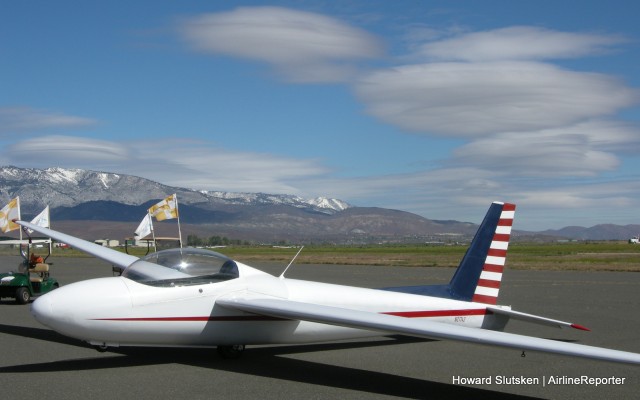
Soaring NV uses this Schweizer 2-32 for sightseeing flights over Lake Tahoe. It was a gorgeous “wave” day when I took this photo, with lennies everywhere!
There’s a couple of other gliders in the staging area, including a Schweizer 2-32. It’s got a back seat big enough for two people to squeeze into. It helps if they’re close friends. Soaring NV uses the 2-32 to fly sightseeing rides over Lake Tahoe. Silvio, the tow plane pilot, is waiting in the cockpit of the Piper Pawnee. I talked to him earlier, and told him that we’d like to head east. He’ll tow us to the area where the last flights had released, and we’ll see if we can find a juicy thermal.
OK, time to climb in. The LS4’s cockpit is cozy. Once I’m settled in, Spencer helps me fasten the four-point harness, one belt over each shoulder, attached to a quick-release on the lap belts. I put my wide, elastic strap around my thigh, and slide my little notebook and pen under it. I tuck a bottle of water by my side, because I know it’s really easy to quickly become dehydrated at altitude. I’ve got my local map, with landmarks noted. Hat on, and I pull the canopy down, carefully, to make sure that I have enough headroom while I’m in this comfortable, semi-reclined position in the LS4’s teardrop fuselage. OK, looks good. Open up again.
Electrical master on, radios on, GPS and navigation computer, all on. I fit the oxygen cannula over the back of my ears, and rest the prongs in my nostrils. Dang, I forgot to turn on the oxygen, so I call Spencer over and he reaches behind and to the side of the seat, and opens the valve. Good, the oxygen is flowing.
The US Federal Aviation Administration (FAA) rulebook says that pilots must use oxygen above 12,500 ft ASL on flights of more than 30 minutes. Once you’re above 14,000 feet ASL, you must use oxygen at all times. But everybody is different, and we all have to figure out what’s best for our physiology. I use oxygen all the time when I fly, because I live at sea level, and the field elevation at MEV is 4,722 ft ASL. I’m not acclimatized to even that altitude, and I’m always surprised how the ’œfuzzies’ go away when I turn on the oxygen. Kinda like a triple-shot latte, but better!
On the radio, I’ve just listened to the robotic voice that’s generated by the AWOS ’“ the Automated Weather Observing System. Light winds at 5 knots, with a bit of a left crosswind. I look over at the windsock, and it confirms the AWOS. Once I’ve made a note of the weather on my pad, I flip the radio over to MEV’s common frequency. Next, even though we’re not flying a cross-country today, I set up the nav computer to show MEV as our next waypoint. That way, I’ll be able to glance down and see the distance to the airport. I double-check that the transponder is set to ’œ1202’, so that Air Traffic Control will be able to track us. Soaring NV’s gliders all have transponders; I’ll tell you more about that when we’re airborne.
All’s good, and now it’s time to pick up the tempo. I tell Spencer that we’re ready to go. There’s no other traffic arriving or departing at the airport, so he radios Silvio, who starts up the Pawnee and taxiies in front of us, dragging the 200-foot-long tow rope. Spencer guides it, and gives Silvio the signal to stop. Spencer brings the end of the rope over to me, and I have a look at the knot and connector. The rope system is designed to break if it’s overstressed; that’s an important safety feature. But sometimes, a rope or fitting just wears out, and fails. That’s the glider version of a low-level engine failure in a single-engine plane ’“ a ’œrope break.’
Glider pilots learn and practice how to quickly and safely respond to a rope break, and you have to demonstrate your ability during your flight test and reviews. Powered-pilots might find it surprising, but most gliders can safely do a 180-degree turn to land downwind on the runway, after a rope break from as low as 200 feet above the ground. Below 200 feet, you’re going to land either straight ahead, or a little bit left or right of your flight path. Get above 200 feet, and the options widen as you gain altitude. As always, we’ll plan our takeoff to expect a rope break. That way, we’ll be ready in case it does happen.
The rope looks good, so Spencer bends down under the glider, holds up his fist, and opens it. That’s the signal to pull and hold the rope release. I follow his instructions, and close the release when he closes his fist. Now we’re connected to the tow plane. Gliders can have two connection points ’“ a nose hook, or a CG hook, at the glider’s center of gravity. The nose hook is pretty well self-explanatory. It’s right at the nose of the glider, and is used for aero-tows. The CG hook can also be used for aero-tows, but it’s the only way to get airborne on a winch tow. Visualize a glider at the top of a winch tow arc with the rope attached, and you’ll figure out why a nose hook doesn’t work very well.
Gliders can have one, or both kinds of hooks. This LS4 only has a CG hook, which is a bit behind the pilot’s seat, attached to the landing gear. A CG hook can make a tow’¦interesting. Take a shopping cart with swivel wheels at each corner. Clip on a rope right in the middle, to the underside of the basket. Now use the rope to pull the cart. Yes, the cart will move towards you, but it’ll also swivel around the attachment point. Just like a glider with a CG hook on tow. I really found out about that on my first flight in this glider. I said that I’d tell you about it, but it’ll have to wait until we get back on the ground. I want to focus now.
Spencer stands up, walks to the glider’s wingtip, and moves his arm back and forth to tell Silvio to take up the slack in the rope. There’s a set of visual signals that pilots, tow pilots, and ground crew must know. They’ve got to be committed to memory. In the air, in an extreme situation, understanding and knowing how to respond to a signal could save your and the tow plane pilot’s life. But all of that is stored in my head, and it’s there if I need it. Time to go flying.
I pull the canopy down, gently, and lock it into place. I run the pre-takeoff checklist, and all’s good. With my left hand, I open the airbrakes to test them one final time, and then close and lock the control. Definitely don’t want them floating up during the tow, because the drag they create will make it almost impossible for the tow plane to do its work. Pushing down on the radio transmit button on the stick, I give Silvio a call to check that my radio working. He confirms that he hears me ’œloud and clear.’
Out loud, I recite my takeoff plan. ’œIf we have a rope break or problem on or close to the runway, release and stop. Below 200 feet, land straight ahead. Winds are light, so at 200 feet, it’s a 180 return to the runway. Above 300 feet, figure it out quickly, and land. Ready!’ I’m primed. I note the time on my pad, flip the transponder on, turn to Spencer, and give him a thumbs up. He lifts and holds the wingtip, so that the wings are level. He’ll run with us for the first part of the takeoff, until I have aerodynamic control of the glider. I take a deep breath, exhale, and waggle the rudder to give Silvio the takeoff signal. Silvio acknowledges by waggling the Pawnee’s rudder, and he makes the radio call, ’œGlider tow departing on Runway 3-0, Minden.’ I hear the Pawnee’s engine rev up, and I’m holding the control stick gently with two fingers as we start to roll’¦
Oh darn, my Editor, David, just told me to hit the [PAUSE] button! I think there’s some other great stories he’d like you to read. But I’ll be back with Part Three, and the conclusion of ’œGone Gliding’. We’ll be flying soon, I promise!
Read the conclusion of “Gone Gliding!”
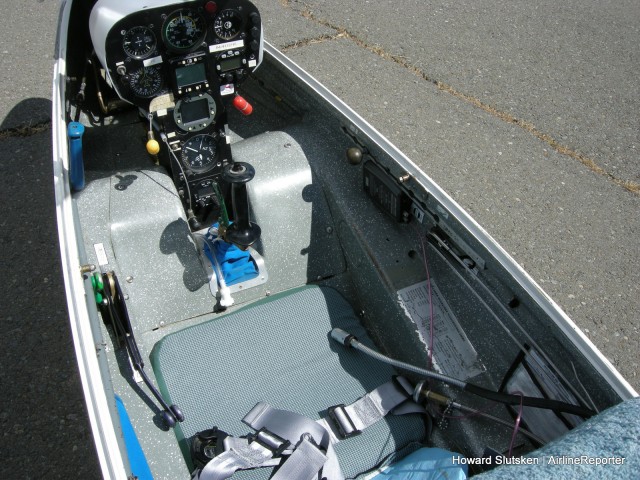
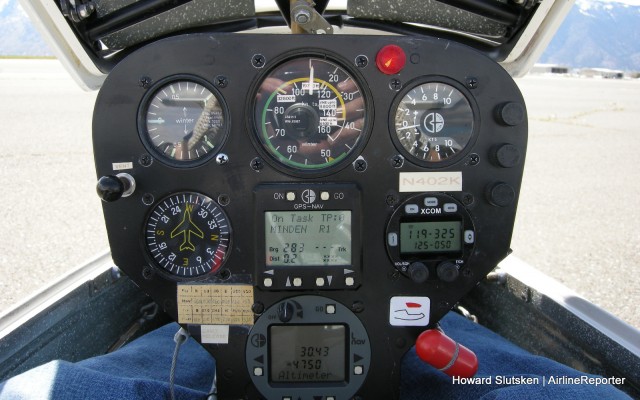
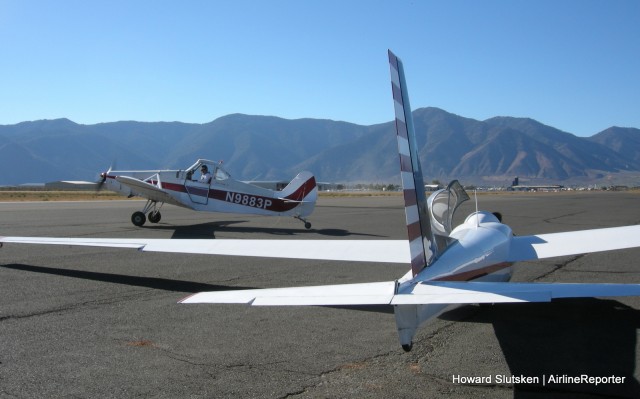
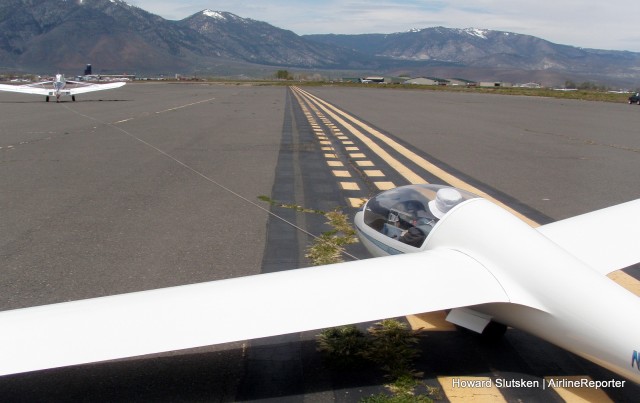
Great article, feel like I was there, can’t wait for part.3, Anyway, what is a winch tow? is it like what i think it is, like flying a kite ?
Hi Zaki, thanks for the comment! I haven’t done a winch tow, but I found this Youtube video from Wales that explains and shows a launch. https://www.youtube.com/watch?v=Y4H47heaWXw
And you’re right, the glider goes up like a kite! The video does show a cable being attached to a nose hook, which surprised me. I thought that winch launches on nose-hook only equipped gliders was unsafe. Any other glider pilots, with experience with winch tows, want to comment?
And if you want to read a really good report on winch launches, here’s a link to “Winch Launch Training Guidelines,” published by Bill Daniels. http://ow.ly/Ek3Yh It explains everything in depth, along with some great charts and diagrams.
thanks for the link, very interesting !
This is great, Howard. You really put me in the cockpit and introduced me to gliding! Really enjoyed it.
Does anyone have a CAD file drawings for the LS4 Instrument panel?